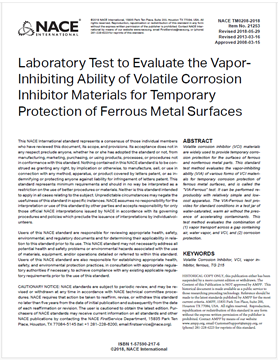Search
Chemical Inhibitors
View as
Sort by
Display
per page
NACE Publication 3T199-2012, Techniques for Monitoring Corrosion and Related Parameters in Field Applications
Product Number:
24203-SG
Publication Date:
2012
$179.00
NACE Publication 41013-2013-SG, "State-of-the-Art Report: External Corrosion, Assessment and Control of Buried Piping Systems in Nuclear Power Plants"
Product Number:
24252-SG
Publication Date:
2013
$109.00
NACE SP0315-2015/IEEE Std 1835-SG, "Standard for Atmospheric (Above Grade) Corrosion Control of Existing Electric Transmission, Distribution, and Substation Structures by Coating Systems"
Product Number:
21188-SG
ISBN:
1-5790-309-1
Publication Date:
2015
$109.00
NACE SP0395-2013 (formerly RP0395), "Fusion-Bonded Epoxy Coating of Steel Reinforcing Bars"
Product Number:
21071-SG
Publication Date:
2013
$179.00
NACE SP0499-2012 "Corrosion Control and Monitoring in Seawater Injection Systems"
Product Number:
21237-SG
Publication Date:
2012
$179.00
NACE SP21469-2021, Corrosion Inhibition Selection and Management for Oil and Gas Production
Product Number:
SP21469-2021
Publication Date:
2021
$109.00
NACE TM0208-2018 "Laboratory Test to Evaluate the Vapor-Inhibiting Ability of Volatile Corrosion Inhibitor Materials for Temporary Protection of Ferrous Metal Surfaces"
Product Number:
21253-SG
Publication Date:
2018
$179.00
New Additives for Environmentally Friendly Coatings
Product Number:
41206-236-SG
Publication Date:
2006
$20.00
Protection of Equipment for Storage and Transport with VCI
Product Number:
51317--9026-SG
ISBN:
9026 2017 CP
Publication Date:
2017
$20.00
Remediation of Microbially Contaminated Horizontal Wells with Acrolein
Product Number:
51320-14992-SG
Publication Date:
2020
$20.00












